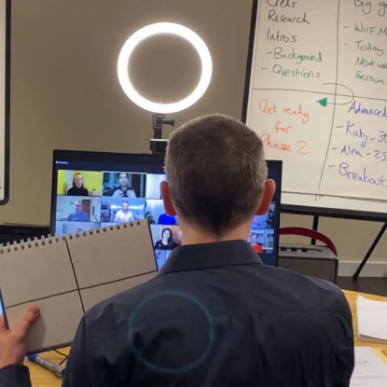The office was in shock as headlines worldwide screamed, ‘Lockdown!’ Our business, built on delivering in-person workshops, suddenly faced a new reality, no more face-to-face sessions, no more global travel. Was this the end?
We paused. Business would go on, but how it was conducted had to change. And it did. We pivoted to online workshops, and our clients embraced the shift, recognising the need to adapt quickly and the pressing need to still communicate well in a virtual world.
This marked the start of an exhilarating journey. Our work focuses on business communication, especially the power of body language. But, as we soon learned, online and in-person communication differ significantly.
Forced to adapt, we uncovered several strategies to make our virtual presentations as engaging as our live ones. We called this new approach ‘digital body language.’ Today, we teach businesses how to adjust their online presence for more impactful communication with colleagues, clients, and customers.
In this blog, I’ll share key insights, how you look, how you sound, and how you come across, as well as broader trends now gaining wider recognition.
Remember, every email, message, and video call is a chance to connect and lead with impact. Your digital communication shapes relationships, influences outcomes, and defines your leadership style. Let’s explore how mastering digital cues can boost your influence and help you communicate confidently, wherever you are.
What is Digital Body Language?
It’s easy to think it’s just body language in a digital space, but it’s so much more than that. When we’re face-to-face body language is obvious – we can see it, sense it, hear it. In a digital environment, it becomes more nuanced, even invisible and that quickly leads to misinterpretation.
Think of digital body language as the choreography of online communication. Just as physical gestures shape our in-person interactions, digital signals, such as how fast you respond, the tone you use in emails, and whether your camera is on, craft how others perceive you. And here’s the thing: it’s like a musical performance; your digital cues create a rhythm that others follow.
Erica Dhawan’s book Digital Body Language highlights how a thumbs-up emoji, seen as positive in the West, can be offensive in parts of Africa, Asia and the Middle East. The result? Misinterpretations can happen, much like a discordant note in an otherwise harmonious tune.
1. Keep the Camera On; It’s Your Digital Handshake
Turning your camera on during virtual meetings shows engagement and presence. It’s like making eye contact in person, it builds trust, rapport, and a sense of connection, even in a digital setting. Your facial expressions, body language, and eye contact play a critical role in communication, helping to convey enthusiasm, attentiveness, and confidence. It also signals to the speaker that you’re fully present and invested in the conversation.
But remember: not everyone is comfortable on video, and there may be valid reasons for keeping the camera off, such as privacy concerns, environmental distractions or even reducing cognitive load. In these cases, be flexible and respectful. Creating a culture where people feel comfortable turning their cameras on is ideal, but it’s equally important to acknowledge different preferences and situations. Encourage engagement through other means, such as active participation in the chat or verbal responses, to ensure everyone feels included and valued, whether they’re on camera or not.
2. Master the Pause in Virtual Meetings
Well-placed pauses in virtual meetings encourage others to contribute. In fast-paced discussions, it’s easy for more vocal participants to dominate, leaving less assertive voices unheard. A pause creates space for reflection, allowing people to gather their thoughts and offering an opportunity for those who may hesitate to speak up.
Pauses also signal that you’re open to hearing from others, reinforcing a collaborative environment. When you deliberately stop speaking, it shows you value others’ input and are making room for contributions. Additionally, pauses reduce the likelihood of interruptions or talking over one another, which can be especially problematic in virtual meetings where visual cues may be harder to interpret. By intentionally using silence, you set the stage for more balanced participation and ensure that everyone, regardless of communication style, has the opportunity to be heard.
Finally, well-timed pauses give weight to your words. They allow your message to sink in and give listeners time to absorb key points before moving forward. This subtle technique not only encourages greater engagement but also creates a more thoughtful, inclusive discussion.
3. Reactions: Your Virtual Nods and Smiles
On platforms like Teams or Zoom, virtual reactions (clapping or smiley emoji) show engagement without interrupting. Why does this matter? These gestures help maintain a positive, interactive environment, much like nodding in a face-to-face meeting. Virtual reactions offer a quick and non-intrusive way to signal agreement, encouragement, or appreciation during a presentation or discussion. This allows the speaker to stay focused without interruptions while still receiving real-time feedback.
In virtual settings, where body language is less visible, reactions provide helpful cues to the speaker. Seeing a clapping icon gives presenters immediate feedback on how their message is landing. It also allows them to gauge the audience’s level of engagement and make adjustments as needed to keep the session engaging.
These reactions also make it easy for everyone to participate, even those who may feel less inclined to speak up. Using simple gestures lets quieter attendees express their thoughts or support without having to jump into the conversation verbally. This creates an inclusive environment where all participants can stay engaged and connected, contributing to a smoother and more dynamic virtual experience.
4. Tone Matters More Than You Think
Without facial expressions or vocal cues, the tone in written communication can easily be misinterpreted. A simple message might come across as cold or abrupt when that’s not the intention. So here’s what to do: Add warmth by starting with a friendly greeting or a brief check-in. These small touches help create a more personal connection, softening the message and showing that you value the relationship.
Additionally, consider using phrases that demonstrate empathy and understanding, especially when discussing sensitive topics. It becomes a superpower. Statements like “I appreciate your perspective” or “I understand your concerns” go a long way in making the conversation feel thoughtful and respectful. You can also adjust your language to sound more conversational, using phrases like “Let’s explore this further” or “What do you think?” to foster collaboration and open dialogue.
Satya Nadella, CEO of Microsoft, often emphasises the importance of empathy in communication. Nadella has been widely recognised for transforming Microsoft’s culture by focusing on empathetic leadership and clear, respectful communication.
In his book Hit Refresh, Nadella discusses how he encourages communication that balances professionalism with empathy:
“There is no such thing as over-communicating. You must lay out your expectations but also show empathy. You need to balance data-driven insights with empathy-driven conversations.”
Nadella emphasises that effective communication isn’t just about getting your message across but ensuring it’s done in a way that builds understanding and connection. This can be seen in his own emails and meetings, where he makes a point to start with empathy, asking how people are doing before diving into work topics. He believes small gestures, like checking in or showing support, can make a big difference in building trust and clarity.
5. Prioritise Your Response Time
A word of caution: Timing is crucial in digital communication. Slow replies can hurt rapport, while a quick response shows attentiveness. If you can’t reply fully, a brief “Thanks, I’ll follow up soon” keeps the conversation flowing. According to Wharton Magazine, setting clear communication norms, like expected response times, eases anxiety and boosts productivity. A study from Lever shows unclear digital messages can cost businesses up to four hours a week in lost productivity.
In Conclusion
Mastering digital body language is like fine-tuning an instrument. Here’s the takeaway: Every message, call, and reaction shapes how you’re perceived. By honing these skills, you can forge stronger connections, build trust, and lead more effectively, even from behind a screen.




















